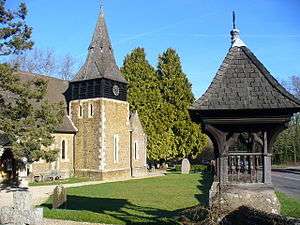Axel Haig

Axel Herman Haig (Swedish: Axel Herman Hägg, 10 November 1835 – 1921) was a Swedish-born artist and illustrator. His paintings, illustrations and etchings, undertaken for himself and on behalf of many of the foremost architects of the Victorian period made him "the Piranesi of the Gothic Revival."[1]
Haig was born on the island of Gotland in the Baltic Sea.[1] His father was a landowner and timber merchant.[1] Haig was apprenticed as a shipbuilder at the government dockyard at Karlskrona and in 1856 went to Glasgow for a further period of training at a firm of Clydeside shipbuilders.[1] But his interests had turned to architecture and in 1859, he undertook a new apprenticeship as a draughtsman in the offices of the Ecclesiastical Commissioners.[1] After seven years there, he launched himself as an architectural artist. The middle years of the nineteenth century saw an explosion in the practice of architectural competitions. The wealth generated by the empire and The Industrial Revolution created the necessary conditions for a vast expansion in civic construction. Commissions for government offices, town halls, churches for private benefactors, railway termini were all put out to tender and competing architects required draughtsmen to illustrate their plans. In 1866 Haig met William Burges when Burges retained him to illustrate his designs for the Royal Courts of Justice in The Strand.[2] Haig produced a series of watercolour illustrations that were "an immediate sensation."[1] The competition's winner, George Edmund Street is said to have remarked, "I wouldn't mind being beaten by drawings like those."[1]
Haig and Burges continued in partnership until the latter's death in 1881. In that time they jointly produced some of the most spectacular medieval visions of the Victorian Gothic Revival. Cardiff Castle, Knightshayes Court, the Church of Christ the Consoler at Skelton-on-Ure, St Mary's Church, Park House, the Speech Room, Harrow School, Castell Coch, Trinity College, Hartford, Connecticut and the designs for the re-decoration of Saint Paul's Cathedral:[3] as Burges designed his most important commissions, so Haig drew them. "In Haig, Burges, the architect of a medieval dreamland, had found an artist worthy of his dreams."[1]
Haig developed a second career as an etcher and his drawings and lithographs of European castles, palaces, landscapes and cathedrals became hugely popular in late-Victorian England.[1] In a review of his work published by RIBA in the year of his death, Maurice Adams wrote that "his architectural draughtsmanship ranks without a doubt amongst the foremost of his time and his graphic capability remains unique."[4]
Haig also designed All Saints Church in Grayswood, Surrey. It was built between 1901 and 1902 in a style described variously as Surrey Vernacular[5] or "13th-century [Gothic] with Arts and Crafts elements". It is a Grade II listed building.[6]

Notes
- 1 2 3 4 5 6 7 8 9 Mordaunt Crook et al. 1984, p 13
- ↑ Axel Haig and the Victorian Vision of the Middle Ages page 16
- ↑ Axel Haig and the Victorian Vision of the Middle Ages page 17
- ↑ RIBA Journal Volume XXVIII (1921)
- ↑ Nairn & Pevsner 1971, p. 262.
- ↑ Historic England. "Church of All Saints, Grayswood Road, Grayswood (Grade II) (1243910)". National Heritage List for England. Retrieved 2 June 2014.
References
- Armstrong, E.A, Axel Herman Haig and His Works (1905) The Fine Art Society, Ltd
- Mordaunt Crook, J. and Lennox-Boyd, C, Axel Haig and the Victorian Vision of the Middle Ages (1984) George Allen and Unwin
- Nairn, Ian; Pevsner, Nikolaus (1971) [1962]. The Buildings of England: Surrey (2nd ed.). Harmondsworth: Penguin Books. ISBN 0-300-09675-5.